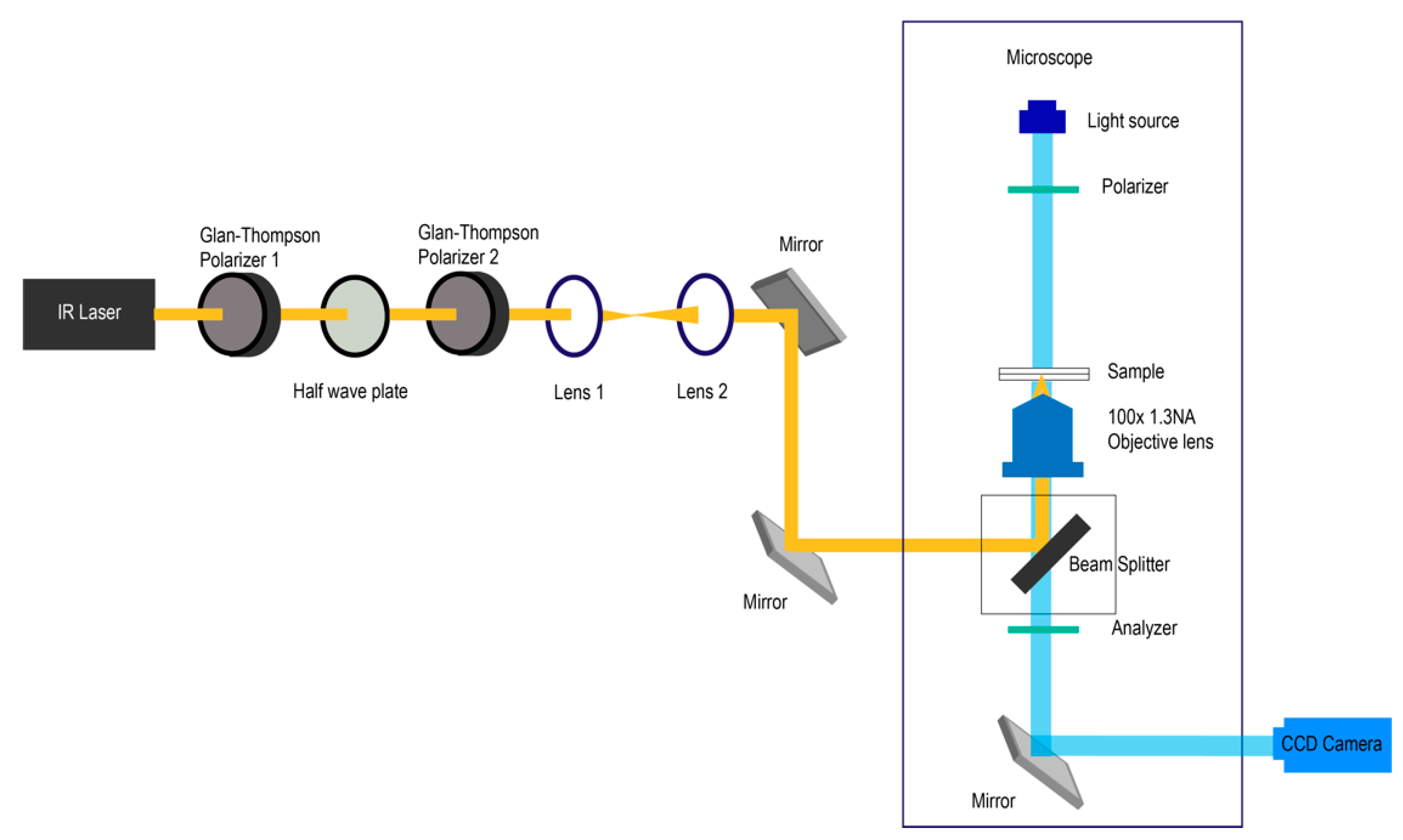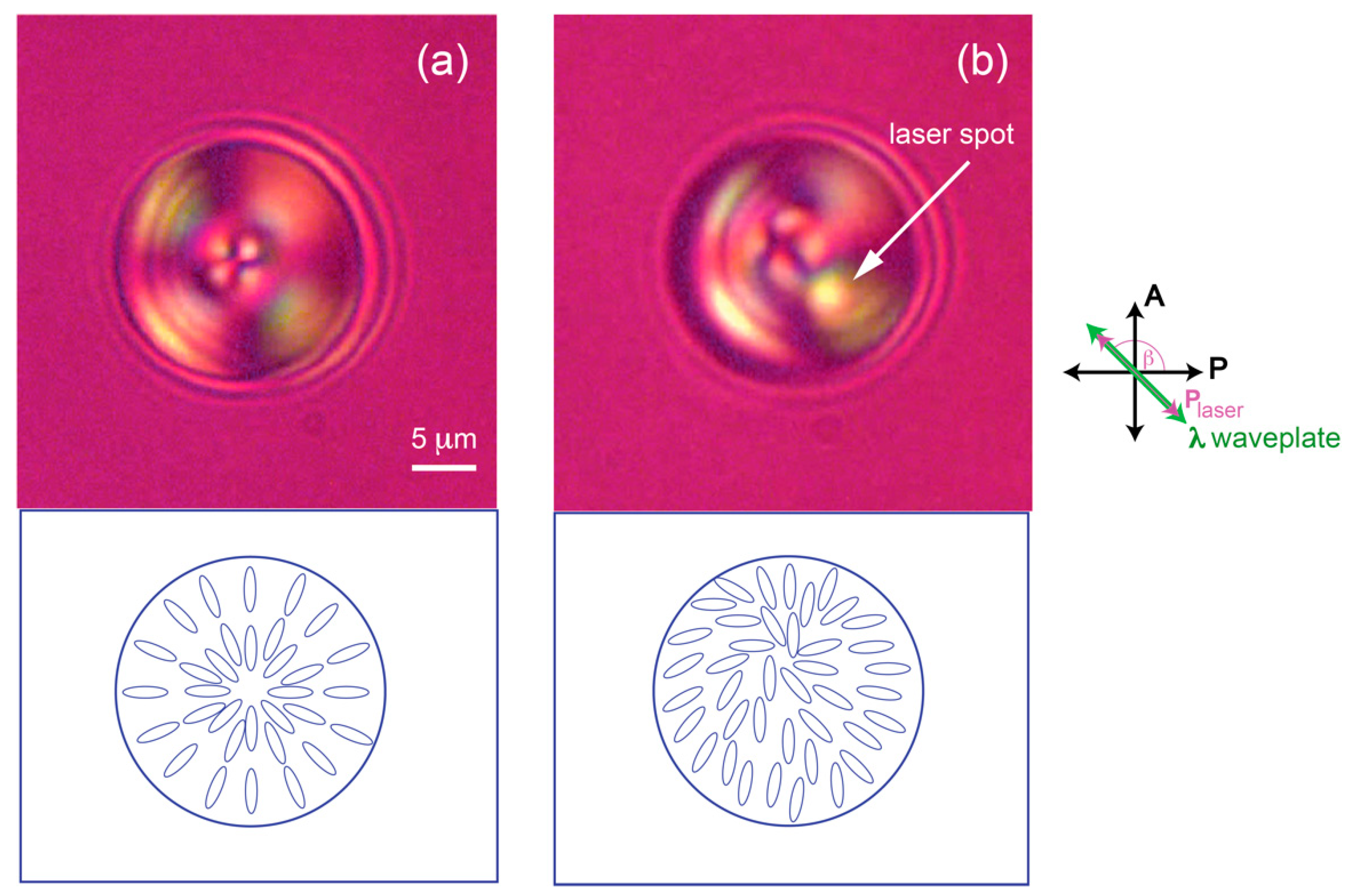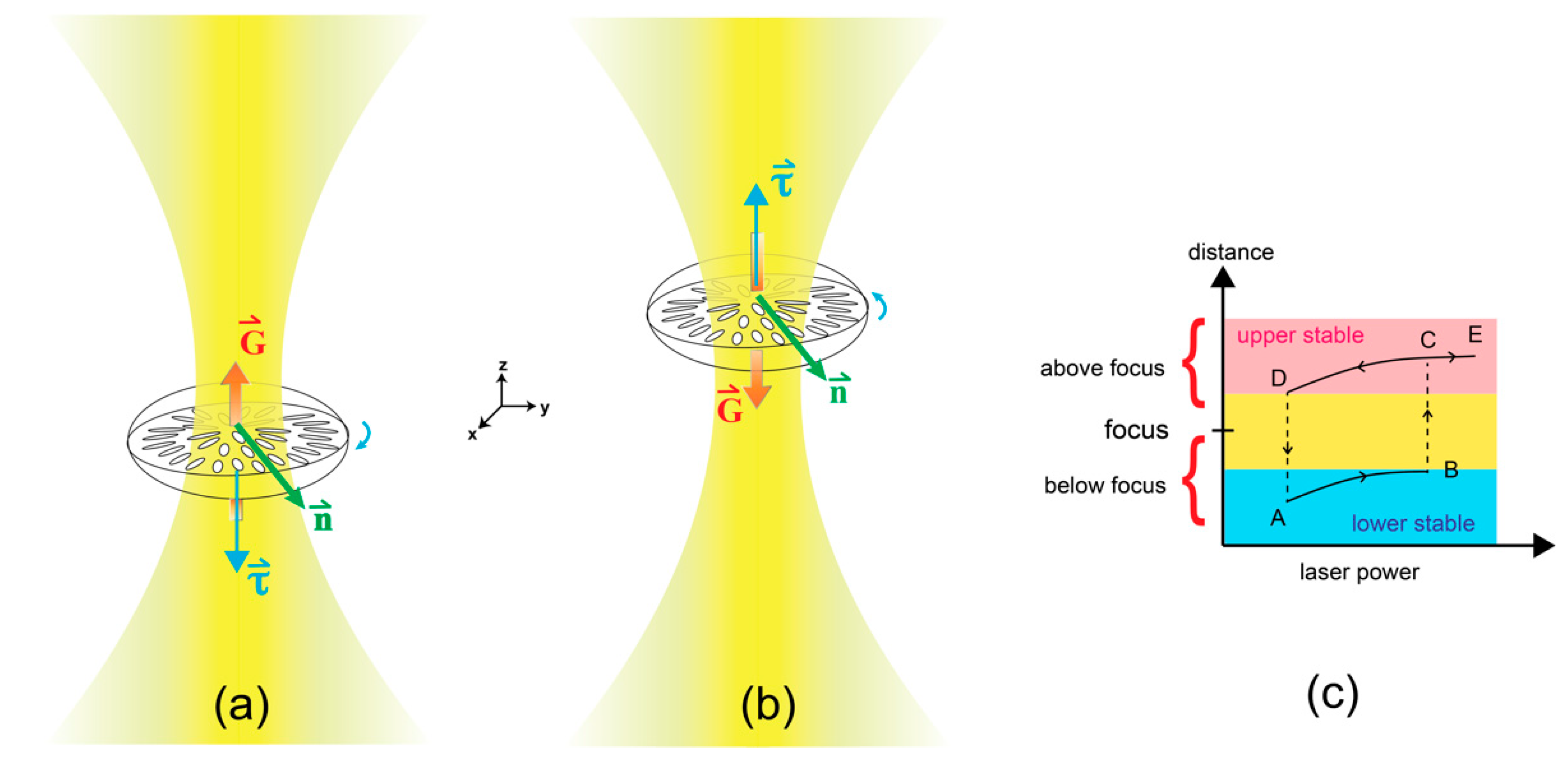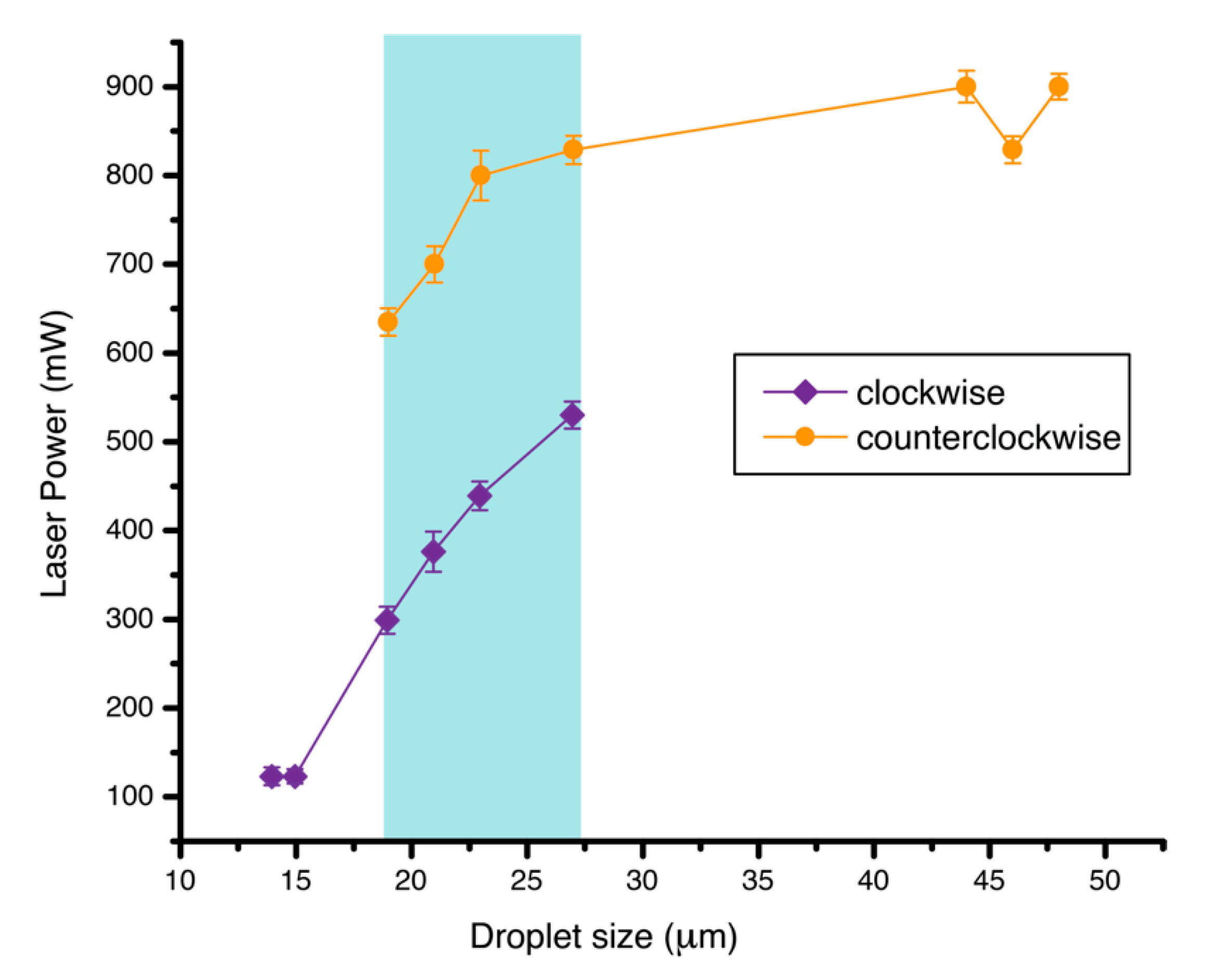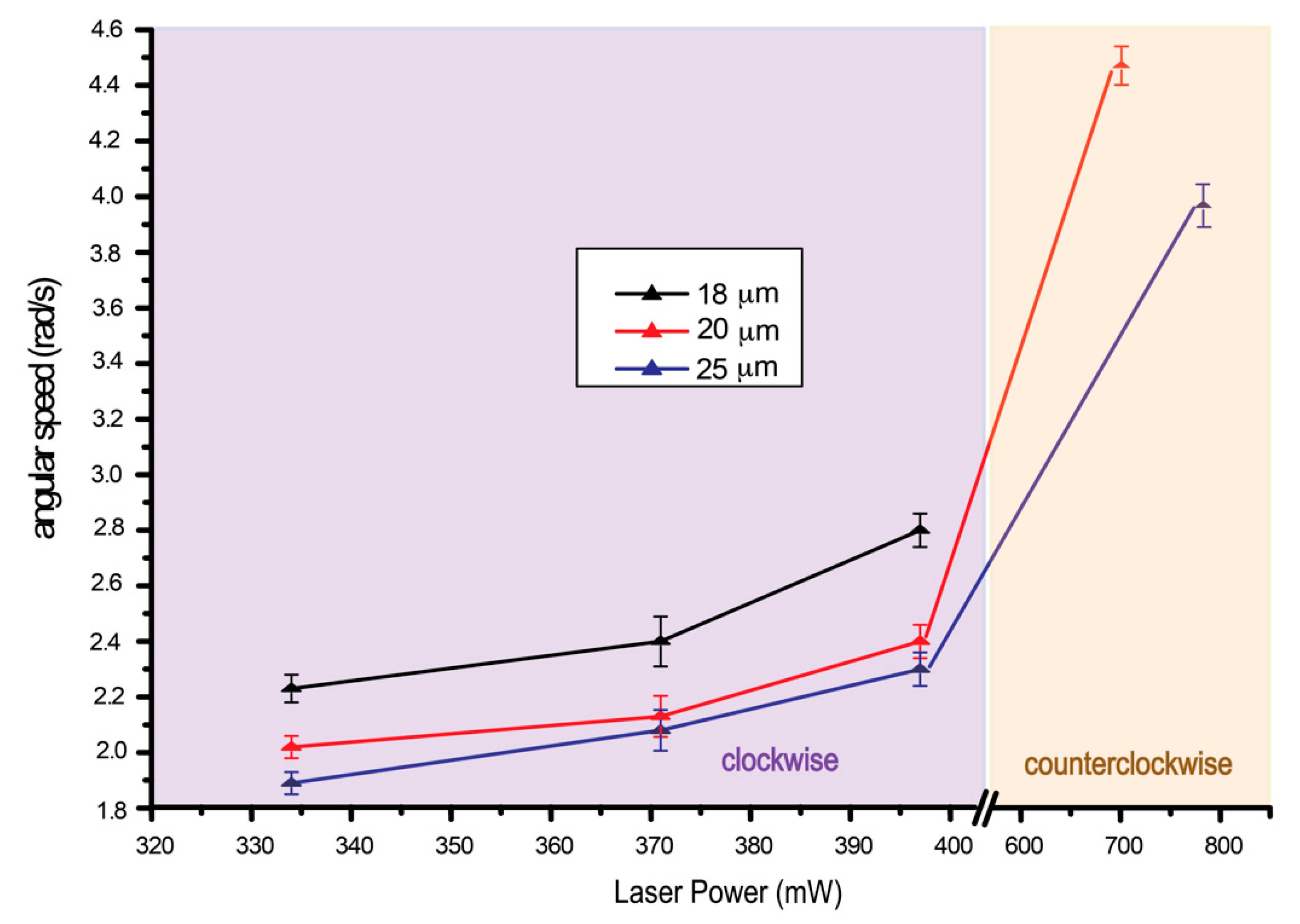1. Introduction
Chiral nematic liquid crystal (NLC), composed of rod-like molecules with symmetry breaking caused by the handedness of the molecules, can form a helical structure with molecular directors twisted around the axis in the chiral nematic phase. Droplets can be created from this type of structure and were found to be rotatable under unidirectional heat flux. This mechanism, so called Lehmann rotation, was first observed by Lehmann in 1900 [
1] and later explained by Leslie [
2]. The Lehmann effect under a temperature gradient was reproduced again after 100 years in an experiment with small drops of cholesteric phase suspended in an isotropic liquid [
3,
4]. Recently, there have been reports of Lehmann rotation in achiral molecules [
5], which had been suggested theoretically by Brand et al. [
6]. This discovery opens the door for liquid crystal scientists to search for more possibilities of finding the Lehmann effect in other macroscopic structures of achiral molecules. Other than subjecting to temperature gradient, there have been a few reports on the Lehmann effect caused by other initiators, e.g., electric field [
7] and fluid flow [
8,
9]. In our experiment, we used linearly polarized light by means of optical tweezers to trap NLC droplets, which apparently caused unexpected rotation of the droplets.
Optical tweezers, discovered in 1970 by Ashkin [
10], use a tightly focused laser beam to trap and move micron sized particles. It has become a powerful tool with extensive applications in biology, physical chemistry, and soft condensed matter physics [
11,
12,
13]. Other than trapping and moving particles, stable levitation of a few micron sized spheres in air and in a vacuum was also demonstrated by Ashkin and Dziedzic [
14,
15]. The balancing of forces from the radiation pressure of the laser and from gravity forms a stable trapping potential [
15]. Optical levitation is useful in many optomechanical systems [
16], especially in ultrasensitive force detection [
17]. In this experiment, we used linearly polarized optical tweezers to create an asymmetric macroscopic structure in achiral nematic droplets [
18,
19] and to optically levitate the droplets. Heat flux is generated by optical levitation whose strength and direction can be controlled by variation of laser power. Here we show that it is possible to exhibit Lehmann rotation of achiral nematic droplets subjected to heat flux under linearly polarized optical tweezers.
3. Results and Discussion
Symmetric radial NLC droplets, the so-called radial hedgehog, were observed with no laser applied as shown in
Figure 2a. During laser trapping experiment, a radial hedgehog defect in the middle of the NLC droplets was pushed off center slightly depending on laser power.
Figure 2b illustrates the off-centered defect in an optical trap after increasing the laser power to 298 mW with its polarization set at an angle β = 135° with respect to the horizontal axis. Molecules inside the droplet tried to orient themselves along the direction of laser polarization due to the optical torque
on the molecules, where
is the molecular director and
is the electric field of the laser along the polarization direction. Symmetry breaking occurred in a radial configuration resulting in the defect being pushed off center [
18,
19] as shown in
Figure 2b. As previously reported by Brasselet [
18] and Phanphak [
19] for linearly polarized optical tweezers, radial NLC droplets were stably trapped with no rotation observed. Mapping of director configuration was obtained by inserting a one-wavelength plate diagonally at an angle of 135° to the horizontal axis. Mapping of director orientation with birefringence color under crossed polarizers and a one-wavelength plate inserted can be modeled as in ref. [
20].
However, in our experiment, a stable trap was only observed in linearly polarized laser trapping whilst slowly increasing the laser power from 124 mW to 298 mW. After a short moment after reaching 298 mW, the defect started rotating around the laser spot in a clockwise direction as shown in
Figure 3. We analyzed the motion by tracking the defect using Tracker video analysis from Open Source Physics (OSP) depicted in
Figure 4a. The experiment was conducted for various sizes of droplets ranging from 14 μm to 48 μm. A 19-μm droplet was selected for detailed investigation.
Figure 4a shows the position of defect over time in clockwise rotation at laser powers of 298 mW and 338 mW. The position
r of the defect was measured with reference to the center of the elliptical trajectory depicted in
Figure 4b. The ellipse appeared to be smaller with increasing laser power, as can be seen in
Figure 4c for the power of 338 mW. During the defect rotation, the motion was non-uniform. The blue square plot in
Figure 4a shows that, for one period of rotation, T = 4.54 s, the defect spends more time at point P than at any other points. The motion was slowed down again at point Q in the trajectory. This non-uniformness was less severe at higher power as illustrated in the pink plot of
Figure 4a for the power of 338 mW. We analyzed the angular speed of the defect for both laser powers (
Figure 4d,e) and found that the contrast of speed was quite high for the lower laser power. The defect preferred to stay at the point along the polarization direction of the laser (point P and Q) as it fell into the linear polarization trapping potential, and speeded up at other positions along the long axis of the ellipse.
When the laser power was increased further than 338 mW, the rotation stopped, and started again in a reverse direction at a higher threshold power. For this 19-μm droplet, the threshold power for rotating in a counterclockwise direction, shown in
Figure 5, is 635 mW. It also rotated in an elliptical trajectory with semi-major axis length
a = 1.50 μm and semi-minor axis length
b = 0.45 μm with a higher frequency of rotation of 0.714 Hz. The elliptical shape was much smaller than with a lower power clockwise rotation. When the laser power reached 830 mW, the droplet stopped rotating and was pushed out of the laser trap at 1.90 W.
Previous observation was done when laser polarization made an angle of β = 135° to the polarizer. Different angles of β at 0°, 45°, and 90° were tried, to check our setup. Changing the angle of polarization changed the elliptical trajectory. The long axis of the elliptical path, as in
Figure 4b,c, followed the axis of laser polarization change. Clockwise rotation was still observed at low power and counterclockwise rotation was observed at high power.
This anomalous rotation in a clockwise and counterclockwise direction can be explained by the fact that along the laser trapping axis there is the gradient temperature,
, pointing toward the focus of the laser. The location of the droplet in the laser trap can be determined from the competition of gravitational force and the radiation pressure of the laser. The beam waist of the focused laser through 100× objective lens was approximately 1 μm which is smaller than the particle size; therefore, this optical tweezers experiment can be considered using a ray optics regime. Optical levitation of a particle in a laser trap, with power, can be explained by the hysteresis loop, in Ashkin’s experiment [
15] on a 19-μm solid glass sphere with TEM00 mode laser, depicted in
Figure 6c. The hysteresis plotted is for a case in which the beam waist is smaller than particle size, which is the same as in our case. When the particle is lifted to the focal point, the vertical force is at a minimum. Our experiment followed along the track from A to B and to C and E in the hysteresis loop by slowly increasing the laser power. From A to B in the region of lower stability or when below focus, the thermal gradient
pointed in +z direction. The Lehmann rotation torque according to Leslie [
2] takes the form:
where
is the Lehmann coefficient and
is the average nematic director. Torque points along −z direction in the lower stable region, which results in clockwise rotation of the droplet, is shown in
Figure 6a. By slowly increasing the laser power, the rotation stopped in our experiment and restarted in a reverse direction at higher power as shown in
Figure 5. We did not find an abrupt reversal of rotational direction from clockwise to counterclockwise direction, as the hysteresis loop suggested, from point B to C. When the droplet is trapped at the focal point, there is no temperature gradient, thus no rotation was observed. By continually increasing the laser power, the droplet was levitated to the region above the focal point, then reverse rotation appeared as depicted in
Figure 6b. At this point, the droplet reached point C in the hysteresis loop. By keeping the power increased, the droplet continued to point E and was pushed off the optical trap.
Notice that the upper stable can also happen at low power laser if the trapping starts from high power and reduces to lower power. We observed this case experimentally; however, for detailed investigation, we only increased the laser power in a forward direction.
The NLC droplet itself belongs to D
∞ point group symmetry which should not show any rotation due to the Lehmann effect [
6]. However, Lehmann rotation of the structure composed of achiral molecules has been reported [
5,
9] and explained theoretically [
6]. In our experiment the droplet itself, although composed of achiral molecules, was distorted due to the laser polarization direction as shown in
Figure 2b. The configuration could possess mirror symmetry after distortion with the mirror plane in the
x-
y plane, as shown in
Figure 6a; however, the gradient of laser intensity along the
z-axis destroys this mirror symmetry by orienting the molecules with stronger force near the laser focus. Therefore, a droplet trapped in the lower stable region or upper stable region is considered to possess C
1 point group symmetry. According to Brand et al. [
6], the C
1 structure is enough to perform the Lehmann effect in a heat gradient.
The rotation mechanism was also investigated for droplets of other sizes. The plot in
Figure 7 shows the threshold power of the laser for droplet rotation in a clockwise and counterclockwise direction, along with droplet size. The most suitable size of the droplet to observe both clockwise and counterclockwise rotation ranges from 19 to 27 μm. Below this range, the droplet is too small so that it only shows rotation in the lower stable region below the focus of laser. At higher laser power, it was pushed out of the optical trap. For the droplets larger than this range, the low power laser was not enough to drive the rotation, thus only counterclockwise direction occurred in the upper stable region.
Further analysis of angular speed for clockwise and counterclockwise rotation is depicted in
Figure 8. It can clearly be concluded from the plot that angular speed of the droplet depends on droplet size and laser power. At low laser power, the droplet rotates clockwise with low angular speed, and at high laser power, the droplet rotates much faster in a counterclockwise direction.
In conclusion, we have shown that achiral nematic liquid crystal can form an asymmetric macroscopic structure under laser trapping, which is sufficient to generate Lehmann rotation under the heat gradient of a linearly polarized laser beam. The rotational sense of the droplet depends on heat gradient direction which can be determined by location of the droplet on the laser beam axis with respect to the laser focal spot. This mechanism, driven by heat flux of the laser, can also be applied to other macroscopically asymmetric structures. Bent core liquid crystals are suggested as a candidate for future investigation.
